SA80
The SA80 is a British family of 5.56×45mm NATO bullpups. The L85 Rifle variant has been the standard issue service rifle of the British Armed Forces since 1987, replacing the L1A1 variant of the FN FAL. The first prototypes were created in 1976, with production of the A1 variant starting in 1985 and ending in 1994. The A2 variant came to be as the result of a significant upgrade in the early 2000s by Heckler & Koch and remains in service as of 2020. The A3 variant was first issued in 2018 with several new improvements.[8]
| SA80 | |
|---|---|
_5.56mm_Rifle_MOD_45162150.jpg) L85A2 with ELCAN LDS and 2009 upgrade suite | |
| Type | Assault rifle Light support weapon Carbine |
| Place of origin | United Kingdom |
| Service history | |
| In service | 1985–present |
| Used by | See Users |
| Wars | See Conflicts |
| Production history | |
| Designed | 1970s–1980s |
| Manufacturer | RSAF Enfield, Royal Ordnance, Ferranti[1][2] |
| Produced | 1985–1994 |
| No. built | Approx. 350,000 (L85, L86) Approx. 21,700 (L98) Approx. 600,000 (Overall figure) |
| Variants | See Variants |
| Specifications | |
| Mass | 3.82 kg (8.4 lb) (L85A2 empty) 4.98 kg (11.0 lb) (L85A2 with SUSAT sight and loaded 30-round magazine)[3][4][5][6][7] 6.58 kg (14.5 lb) (L86A2 LSW with SUSAT sight and loaded magazine)[3] 3.52 kg (7.8 lb) (L22A2) |
| Length | 785 mm (30.9 in) (L85A2[3] & L98A2) 900 mm (35.4 in) (L86A2 LSW)[3] 565 mm (22.2 in) (L22A2) |
| Barrel length | 518 mm (20.4 in) (L85A2[3] & L98A2) 646 mm (25.4 in) (L86A2 LSW)[3] 285 mm (11.2 in) (L22A2) |
| Cartridge | 5.56×45mm NATO |
| Action | Gas-operated, rotating bolt |
| Rate of fire | 610–775 RPM[3] |
| Muzzle velocity | 930-940m/s[3] (L85,[5][6] L98[7]) 950-970m/s[3] (L86[5][6]) 780m/s (L22[5][6]) |
| Effective firing range | 300-400m[3] (L85, L98 rapid fire)[4][5][6][7] 600m (L85, L98 section fire)[4][5][6][7] 800-1000m[3] (L86)[4][5][6][7] 200m (L22)[5][6] |
| Feed system | 30-round detachable STANAG magazine 30-round detachable polymer Magpul EMAG |
| Sights | Telescopic SUSAT, ACOG and ELCAN LDS scopes, aperture iron sights |
The remainder of the SA80 family comprises the L86 Light Support Weapon, the short-barrelled L22 Carbine and the L98 Cadet rifle.
The SA80 was the last in a long line of British weapons (including the Lee–Enfield family) to come from the Royal Small Arms Factory, the national arms development and production facility at Enfield Lock.
History
Development
The idea dates back to the late 1940s, when an ambitious programme to develop a new cartridge and new class of rifle was launched in the United Kingdom based on combat experience drawn from World War II. Two 7mm prototypes were built in a bullpup configuration, designated the EM-1 and EM-2. When NATO adopted the 7.62×51mm NATO rifle cartridge as the standard calibre for its service rifles, further development of these rifles was discontinued (the British Army chose to adopt the 7.62 mm L1A1 SLR semi-automatic rifle, which is a licence-built version of the Belgian FN FAL).
In 1969, the Enfield factory began work on a brand new family of weapons, chambered in a newly designed British 4.85×49mm intermediate cartridge. While the experimental weapon family was very different from the EM-2 in internal design and construction methods, its bullpup configuration with an optical sight was a clear influence on the design of what was to become the SA80. The system was to be composed of two weapons: the XL64E5 rifle (also called the Enfield Individual Weapon) and a light support weapon known as the XL65E4 light machine gun.[9]
The sheet metal construction, and the design of the bolt, bolt carrier, guide rods, gas system and the weapon's disassembly showed strong similarities to the Armalite AR-18 which was manufactured under licence from 1975 to 1983 by the Sterling Armaments Company of Dagenham, Essex,[10][11][12][13][14] and which had been tested by the UK MoD in 1966 and 1969.[15][14]
During the development of the SA80, a bullpup conversion was made of an AR-18 and a Stoner 63[16][17][18] at Enfield due to the fact they could be used with stocks folded/without stocks which allowed the bullpup conversion and were later chambered in the experimental 4.85x49mm round. A bullpup conversion of the AR-15 was previously considered but the buffer tube in stock prevented the idea from reaching fruition.[19][20][21]
Technically, in the mid-1970s, the 4.85×49mm round was seen as superior to the then existing version of 5.56mm M193 round in use by the US (for the M16/M16A1) and by other forces. (This was the expressed view of trials team members whilst demonstrating the XL64E5 prototype at the British Army School of Infantry at Warminster.) Development of small-arms munitions have a long and continuous life and it was estimated by the trials specialists from Enfield that this weapon would ultimately be superior in the 4.85mm configuration. For the 4.85mm round, both propellant and projectile were at the beginning of their respective development curves. Also, weight for weight, more rounds of ammunition could be carried by an individual soldier – a considerable advantage on the battlefield. It was regarded as probable at the time that the argument for the 5.56mm standard within NATO had more to do with the economics involved. Over the lifetime of a small-arms weapon type, far more money is spent on the munitions than the weapons themselves. If the 5.56mm supporters had lost the argument in favour of a British 4.85mm round, the economic impact would have been very large and political pressure undoubtedly played a part in the final decision.
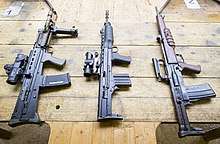
In 1976, the prototypes were ready to undergo trials. However, after NATO's decision to standardise ammunition among its members, Enfield engineers re-chambered the rifles to the American 5.56×45mm NATO M193 cartridge. The newly redesigned 5.56mm version of the XL64E5 became known as the XL70E3.[22] The left-handed XL68 was also re-chambered in 5.56×45mm as the XL78. The 5.56mm light support weapon variant, the XL73E3, developed from the XL65E4, was noted for the full-length receiver extension with the bipod under the muzzle now indicative of the type.[23]
Further development out of the initial so-called "Phase A"[23] pre-production series led to the XL85 and XL86.[24] While the XL85E1 and XL86E1 were ultimately adopted as the L85 and L86 respectively, a number of additional test models were produced. The XL85E2 and XL86E2 were designed to an alternate build standard with 12 components different from E1 variants, including parts of the gas system, bolt, and magazine catch. Three series of variants were created for "Environmental User Trials". XL85E3 and XL86E3 variants were developed with 24 modified parts, most notably a plastic safety plunger. The E4's had 21 modified parts, no modification to the pistol grip, and an aluminium safety plunger, unlike the E3 variants. Lastly, the E5 variants had 9 modified parts in addition to those from the E3/E4 variants.[23]
SA80 development was complicated from the start. One complication was at least three project staffing changes at the Royal Small Arms Factory, which resulted in repetition of testing several times. One problem with the design of the gun itself was that the cases would be ejected at constantly varying angles as it heated up and the rate of fire changed, resulting in a large ejection port.[25] The conversion from 4.85mm to 5.56mm also caused a complication, as the rate of fire dropped but the pressure and time curve of the rounds were different. The 4.85mm round was based on the 5.56mm case in anticipation of the need to convert calibres. The barrel was changed easily, but the gas ports were much larger. Pressure problems had less of an effect on the LSW due to its longer barrel.[26]
Production
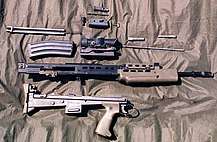
_5.56mm_Rifle_MOD_45162152.jpg)
After receiving feedback from users and incorporating the various design changes requested, including adapting the rifle for use with the heavier Belgian SS109 version of the 5.56×45mm round and improving reliability, the weapon system was accepted into service with the British Armed Forces in 1985 as the SA80. The SA80 family originally consisted of the L85A1 Rifle, the L86A1 Light Support Weapon (LSW), and L98A1 Cadet GP Rifle. The first weapons were issued in October 1985.[27][10]
The SA80 family was designed and produced by the Royal Small Arms Factory at Enfield Lock. In 1988, production of the rifle was transferred to the Nottingham Small Arms Facility owned by Royal Ordnance (later British Aerospace, Royal Ordnance; now BAE Systems Land & Armaments). It was envisaged that the family would replace the L1A1 SLR, the L2A3 Submachine Gun (SMG), the L4 Light Machine Gun (LMG), and the L7A2 General Purpose Machine Gun (GPMG) as used at section level; regular infantry, Royal Marine units, and the RAF Regiment were to change over by 1987, remaining regular army units by 1990, remaining RAF units by 1991, Territorial Army units by 1991–3, and the Royal Navy by 1993. In 1994, production was officially completed; more than 350,000 L85 rifles and L86 LSWs had been manufactured for the British Armed Forces, with the former variant comprising 95% of the total run,[27] while over 21,700 L98A1 rifles were produced for cadet use.[28] The production line was broken up shortly afterwards, with the Nottingham facility itself closing in 2001. Upgrade programmes and requirements for spare and replacement parts have since been fulfilled by then British-owned Heckler & Koch, which later reopened the Nottingham site for this purpose.[29]
As responsibility for the funding and supply of the home defence regiments of the British Overseas Territories has been handed to the local governments of the territories (despite the regiments themselves coming under command of the national (British) government and being loosely integrated with the British Army), the SA80 was not automatically supplied to these units. The Bermuda Regiment[note 1] adopted the Ruger Mini-14 in 1983, although small stocks of the L85 were also acquired for the purpose of familiarisation training as many of its personnel attend courses or attachments in Britain;[30] the Regiment would later go on to acquire an additional 400 L85A2 rifles in 2015 to replace the Mini-14 as the standard issue rifle.[31] The Royal Gibraltar Regiment, which is more closely integrated with the British Army, adopted the SA80 from the outset, while the Falkland Islands Defence Force adopted the Steyr AUG (another 5.56x45mm rifle produced in a bullpup configuration)[32] which served until 2019 when the Defence Force adopted the L85A2 as part of a wider effort to align its weapons, training and procedures with those of the British Armed Forces.[33]
The L85 is also in use with the Jamaica Defence Force.[34] Various African and South American countries would also receive SA80s as part of wider military aid packages.[27]
Design flaws
Soon after being adopted for service, problems began to surface during troop trials held between 1986 and 1987. Components were found to be insufficiently robust, the LSW's bipod lock often failed to hold the bipod legs in closed position, the plastic furniture was melted by insect repellent, metal parts were quick to rust in jungle environments, and the weapon's mechanism was highly susceptible to dusty and arctic environments.[27][35]
These problems were not helped by the production process. The SA80 series was produced from metal stampings; while RSAF Enfield had previous experience in manufacturing stamped-metal firearms, this was only in relation to weapons such as the Sten submachine gun that had relatively loose tolerances. The tighter tolerances required by the SA80 would soon lead to production delays and high wastage levels. There were also issues with regard to working practices and employee attitudes at the Enfield site which were exacerbated by its closure in 1988 and resulting redundancies;[27] one worker was recorded as saying that "Having been shafted by BAE and our own management, we thought why the hell should we care if [the SA80] worked or not. All we wanted to do was see the last of the bloody things and leave."[36] While production at the Nottingham facility was supposed to result in better-quality weapons owing to the use of newer manufacturing methods,[35][37] few of the staff working there had any experience of firearms manufacture and only 15 to 20 components were actually produced inhouse (compared to the Enfield site's total of 230) with the rest being outsourced to subcontractors; since the plant kept low stocks of pre-produced components, significant delays were incurred if subcontracted components were late in arriving at the Nottingham site or did not meet required tolerances.[27]
When the L85A1 and L86A1 were first sent into major combat during the Gulf War, individual performance was appalling. The L85A1 proved unreliable in semi-automatic mode, and slightly better in fully automatic mode, while the opposite was true of the L86A1. Specific complaints included: the poor quality plastic furniture fell apart and the gun was damaged easily; the magazine release catch was easily knocked accidentally and dropped the magazine; the catch on the top cover over the gas mechanism was too weak and constantly popped open, so it had to be taped down; only 26–28 rounds could be loaded in a magazine because the springs were weak (something that was also mentioned in training manuals, at least with regard to earlier Colt-produced magazines[4]), and it also had to be kept very clean and the lips checked for dents. The magazine was made from aluminium and would deform if grasped too tightly. During firing this could choke the flow of rounds and result in a jam; the LSW had a small magazine capacity for its role and overheated after 120–150 rounds fired in bursts; the weapons were difficult to strip and reassemble, with the gas plug easily jamming in place and requiring an armorer to remove; the firing pin was too narrow and would snap; the back of the trigger surface was flat which with snow or dirt accumulating behind it would prevent the trigger from pulling back all the way and firing the gun; and ergonomic issues related to the safety catch, cocking lever, and the location and stiffness of the fire selector switch.[26] During Operation Palliser and other intervention operations in Sierra Leone, it was discovered that the version of the safety plunger used for production weapons was made from cheap injection-moulded plastic that swelled when wet, potentially rendering weapons inoperative if they had been left on 'safe'.[27]
The SA80 initially gained a poor reputation amongst British soldiers as being unreliable and fragile, a fact picked up by the UK media,[38] entertainment industry,[39] and members of the House of Lords.[40] Chris Ryan regarded the SA80s as being "poor-quality, unreliable weapons at the best of times, prone to stoppages, and it seemed pretty tough to have to rely on them",[41] while his fellow Bravo Two Zero patrol member Andy McNab said that:
The Regiment tried SA80s in jungle training when they came out, and found it not best suited to its requirements. [...] If rifles were cars, instead of going for a Ford Sierra 4x4 – good, reliable, tested and enjoyed by the people who drive them — in the SA80 the Army went for a Rolls-Royce. But at the stage when it was first brought into service, it was still a prototype Rolls-Royce, and there were plenty of teething problems.
— Andy McNab, 1993[42]
Immediately after the first Gulf war (Operation Granby), the Ministry of Defence (MOD) commissioned the LANDSET Report (officially entitled "Equipment Performance (SA80) During Operation Granby (The Gulf War)"), into the effectiveness of the L85A1 and L86A1. This report criticised the acceptance of the weapon into service. Neither weapon had managed to pass the sand trials and both frequently jammed. The mechanism of both weapons needed to be well lubricated as the weapon became prone to seizure if fired "dry", yet in a sandy environment the lubricated weapon became unreliable due to the lubricant attracting sand into the moving parts. The LANDSET report identified in excess of 50 faults, most notably the magazine release catch, which could easily be caught on clothing and therefore accidentally release the magazine; the plastic safety plunger which became brittle in cold climates; and firing pins that were not up to repeated use, and prone to fracture if used in automatic fire mode. The report concluded that:
[The] SA80 did not perform reliably in the sandy conditions of combat and training. Stoppages were frequent despite the considerable and diligent efforts to prevent them. [...] It is extremely difficult to isolate the prime cause of the stoppages. It is, however, quite clear that infantrymen did not have CONFIDENCE in their personal weapon. Most expected a stoppage in the first magazine fired. Some platoon commanders considered that casualties would have occurred due to weapon stoppages if the enemy had put up any resistance in the trench and bunker clearing operations. Even discounting the familiarisation period of desert conditions, when some may have still been using the incorrect lubrication drill, stoppages continued to occur.
— LANDSET Report, 1991[36]
The report was leaked to the press, at which point the Ministry of Defence claimed that it was fake; while it was later admitted that the report was a genuine document, the MOD continued to downplay its significance, and only seven of the 50 faults identified were addressed by subsequent modifications, meaning that complaints over reliability in service continued. The MOD finally began to take the SA80 family's issues seriously in 1992, but procuring entirely new weapons was considered too expensive.[27][26]
A2 upgrade programme
As a result, a more extensive modification programme was executed. In 2000, Heckler & Koch, at that time owned by the British defence conglomerate BAE Systems, was contracted to upgrade the SA80 family of weapons. 200,000 SA80s were re-manufactured at a cost of £400 each, producing the A2 variant. Changes focused primarily on improving reliability and include: a redesigned cocking handle, modified bolt, extractor and a redesigned hammer assembly that produces a slight delay in the hammer's operation in continuous fire mode, improving reliability and stability. Both the rifle and the LSW underwent modifications, and the programme also saw the introduction of a carbine variant.[43] The Ministry of Defence describes the A2 revision as "producing the most reliable weapons of their type in the world".[44] Armed Forces trials indicated extremely good reliability over a range of climates for various operational scenarios, though with a decline in reliability in hot, and especially hot and dry conditions.[27][26]
The L85A2 has achieved an average reliability rate of 25,200 mean rounds between failure, and the L86A2 achieved 12,897 mean rounds between failures. Both weapons have higher reliability rates in cold/dry, temperate, and hot/wet conditions (over 31,500 MRBF for L85A2), but lower rates in hot/dry environments. The minimum expected life of A2 components is 10,000 rounds, meaning they may never suffer stoppages during their lifetimes. The L85A1 was required to be able to fire 120 rounds over 24 hours, and the L86A1 was required to fire 800 rounds in 24 hours. The L85A2 is required to fire 150 rounds in 8 minutes 40 seconds, and the L86A2 is required to fire 960 rounds in 36 minutes. Originally slated for introduction in 2002,[45] the first A2-style SA80 weapons were rushed into action in Afghanistan in December 2001, and all 200,000 were converted by February 2006. Three to four thousand weapons were converted per month. Despite the modifications, reports started to emerge that the L85A2 was still jamming; in reality, there were few jams and problems were much less serious than they were made out to be, since they stemmed from isolated cases of soldiers not cleaning their weapons correctly.[26] The modified A2 variants are distinguished by the "HK A2" marking on the top of the weapon just forward of the buttplate and the distinctive comma-shaped cocking handle (shaped to aid the ejection of the empty round casing and prevent stoppages).
Continued testing of the L85A2 in adverse conditions demonstrates its reliability over contemporary rifles, including the M16. Although it is heavier than most conventional and more modern bullpup rifles, its full-length barrel gives higher muzzle velocities and better terminal performance than both the American M4 carbine and M16 assault rifle. Rounds from an M4 will only reliably fragment out to 50–100 metres, while the L85A2 and M16 allowed fragmentation out to 150–200 metres and the L86A2 has an even longer fragmentation range.[26] Despite these modifications, the L86A2 did not overcome efforts to replace it with a belt-fed machine gun. British troops were issued with FN Minimi machine guns to add suppressive fire out to 300 metres; despite these officially being supplementary weapons, they all but replaced the L86.[27][26]
A further upgrade including the provision of ACOGs, a Daniel Defense-designed RIS handguard for the L85 rifle (with optional Grip Pod downgrip),[46] and a new vortex style flash eliminator was introduced as an Urgent Operational Requirement; initially introduced for use by selected units in 2007,[47] the upgrade package was subsequently rolled out on a more general basis from 2009 onwards.[27][6]
A3 upgrade programme
The SA80A3 was first unveiled in prototype form in September 2016[48] with working models on display in September 2017 at the Defence and Security Equipment International event[49] and official adoption taking place in 2018.[8][29] The changes from the SA80A2 design include a modification to the upper receiver and a full-length rail system for optional add-ons such as a vertical foregrip, laser pointer and torch. It also includes a weight saving of 100 g and a new Flat Dark Earth coating offering improved durability and better camouflage across various environments. The Mid Life Improvement (MLI) project received an initial investment of £5.4 million and will see 5,000 weapons upgraded initially, with plans for more weapons to be upgraded in the future. The MLI project should see the weapon in service with the British military beyond 2025.[29][50][51] Only the L85 rifle has been announced as being upgraded so far; the L86 LSW will not be upgraded as it is being withdrawn from use.[52]
Design details
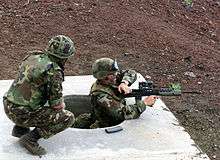
Operating mechanism
With the exception of the L98A1, the SA80 system is a selective fire gas-operated design that uses ignited powder gases bled through a port in the barrel to provide the weapon's automation. The rifle uses a short-stroke gas piston system located above the barrel, which is fed gas through a three-position adjustable gas regulator. The first gas setting is used for normal operation, the second ('Excess') is for use in difficult environmental conditions, while the third setting ('Off') prevents any gas from reaching the piston and is used to launch rifle grenades.[4][5][6] The weapon uses a rotating cylindrical bolt that contains seven radially mounted locking splines, an extractor and casing ejector. The bolt's rotation is controlled by a cam stud that slides inside a helical camming guide machined into the bolt carrier.
Features
The family is built in a bullpup layout (the action is behind the trigger group), with a forward-mounted pistol grip. The main advantage of this type of arrangement is the overall compactness of the weapon, which can be achieved without compromising the barrel length, hence the overall length of the L85 rifle is shorter than a carbine, but the barrel length is that of an assault rifle. While left-handed conversion kits were trialled, the weapon as finally issued must be used exclusively right-handed since the ejection port and cocking handle (which reciprocates during firing) are on the right side of the receiver, making aimed fire from the left shoulder difficult. This can also give rise to a tactical disadvantage when firing around the left side of cover, where the shooter must expose the majority of his body.[27] However left shoulder firing can be achieved by tilting the right hand side of the rifle downwards, reducing the impediments of the cocking handle and the ejection port; the MOD also maintains that left-handed soldiers are as capable of accurately firing the weapon from the right shoulder as right-handed soldiers are.[26][27]
The SA80 family is hammer-fired and has a trigger mechanism with a fire-control selector that enables semi-automatic/repetition and fully automatic fire (the fire selector lever is located at the left side of the receiver, just aft of the magazine). A cross bolt type safety prevents accidental firing and is located above the trigger; the "safe" setting blocks the movement of the trigger. The magazine release button is placed above the magazine housing, on the left side of the receiver. When the last cartridge is fired from the magazine, the bolt and bolt carrier assembly lock to the rear.
The SA80 barrel features a flash eliminator which serves as a mounting base for attaching a blank firing attachment; it also allows for the use of rifle grenades or a bayonet with the rifle variant.
The weapon's receiver is made from stamped sheet steel, reinforced with welded and riveted machined steel inserts. Synthetic materials such as nylon were used to fabricate the furniture and the safety plunger.[27]
Sights

Rifles used by the Royal Marines, British Army infantry soldiers (and other soldiers with a dismounted close combat role) and the RAF Regiment are equipped with a SUSAT (Sight Unit Small Arms, Trilux) optical sight, with a fixed 4× magnification and an illuminated aiming pointer powered by a variable tritium light source (as of 2006 almost all British Army personnel deployed on operations have been issued SUSATs); this is also the standard sighting arrangement for the LSW variant. Mounted on the SUSAT's one-piece, pressure die-cast aluminium body are a set of back-up iron sights that consist of a front blade and small rear aperture. Rifles used with other branches of the armed forces when not on operations are configured with fixed iron sights, consisting of a flip rear aperture housed inside the carrying handle and a forward post vertical blade foresight, installed on a bracket above the gas block. The rear sight can be adjusted for windage, and the foresight—elevation. In place of the SUSAT, a passive night vision CWS scope can be used.[4][5]
Weapons used by some Royal Marines, Infantry, RAF Regiment, Ministry of Defence Police and other soldiers with a dismounted close combat role in operations in Afghanistan have had the SUSAT replaced with the Trijicon Advanced Combat Optical Gunsight (ACOG).[27] In 2011, the Ministry of Defence began issuing ELCAN SpecterOS 4× Lightweight Day Sights (LDS) in an effort to replace ageing SUSAT units across the British Armed Forces, forming the first stage of the FIST infantry enhancement project.[53] In order to mount the new sight, the weapon has been provided with an adapter to convert the existing sight rail to the Picatinny standard, in keeping with the updated handguard. The FIST project has also seen upgrades to the existing Qioptiq CWS (4×) and Maxi-Kite (6×) night vision scopes, and the introduction of the FIST Thermal Sight, following operational experience with the VIPIR-2+ thermal weapon sight in Afghanistan. All of the new FIST weapon sights have the capacity to accept Shield's Close Quarter Battlesight reflex sight.[54]
Magazines

SA80 weapons are fed from a STANAG magazine, usually with a 30-round capacity. Initially issued magazines were aluminium Colt magazines[4] which were not particularly robust, leading to a steel replacement being produced by ROF Radway Green[27]. Heckler & Koch introduced two new steel magazines during the A2 upgrade programme; the main variant is for live ammunition, and the other is exclusively used for blank ammunition. The blank variant is identified by yellow stripes on the magazine, and is designed to prevent the unintentional loading of live rounds. This magazine has less internal length so that live rounds will not fit, while still fitting blank rounds, which are shorter. Blank rounds will fit into the live-round magazine, but the difference in length increases the chance of a stoppage.[5][6][27] The Magpul Industries polymer EMAG magazine was introduced from 2011, featuring a lower weight of 130g compared to the steel magazine's 249g, a detachable dust cover, and a clear window in the magazine body that allows easy monitoring of how much ammunition remains in the magazine.[6][55][56][27] The Beta C-Mag was trialled in an attempt to improve the L86's limited ability to lay down sustained fire, but reliability problems with the magazine when loaded with British-issue ammunition meant that it was not adopted.[27]
Bayonet
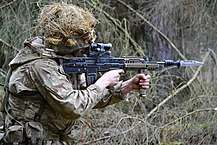

In British Armed Forces use, the L85 Rifle is issued with the socket-type L3A1 Bayonet, which has a hollow handle that fits onto the muzzle. The blade is offset to the side of the handle to allow the rifle to be fired while the bayonet is fitted; it is shaped to produce good penetration when thrust and to part a person's ribs without embedding into bone, and a ribbed section for rope cutting. The bayonet handle is shaped so as to allow the bayonet to be used as a fighting knife in its own right. The issued scabbard features a saw blade for use on wood, a sharpening stone to hone the bayonet, and a bottle opener; when combined with the bayonet, it also forms a wire cutter.[4][5][6][27] When soldiers from the Princess of Wales's Royal Regiment went into battle with fixed bayonets on their SA80s during the Battle of Al Amara on 14 May 2004, it was the first time fixed bayonets had been used by British troops since the Falklands War;[57] on several occasions, fixed bayonets have also been used during the Afghanistan conflict.[27] The bayonet cannot be fitted to the L22 Carbine[58] or L86 Light Support Weapon; as a result, soldiers equipped with the latter would sometimes swap their weapons for vehicle crewmen's L85s when clearing trenches during Operation Granby.[27]
Accessories
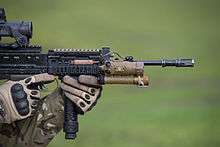
The SA80 is supplied with a sling, blank-firing adaptor, and cleaning kit. The rifle can be adapted to use .22 Long Rifle training ammunition with a special conversion kit.[4][7] The Small Arms Weapons Effects Simulator can be used on the L85 when in training with blank ammunition. On operations with ground close combat units (Infantry, Royal Marines, RAF Regiment), the rifle is often fitted with an LLM01 Laser Light Module.[59][60]
Variants
There are four main variants that make up the SA80 family: the L85 Rifle, the L86 Light Support Weapon, the L22 Carbine and the L98 Cadet rifle.
Rifle
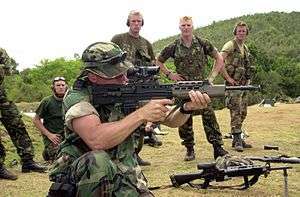
_MOD_45160296.jpg)
The L85 Rifle[4][5][6], referred to on occasion as the L85 Individual Weapon (IW)[3], is the standard rifle for the British Armed Forces.[61]
When initially adopted for service, the L85's grenade-launching capability was fulfilled by then-conventional rifle grenades, namely the L74A1 HEAT and L75A1 HEAT-APERS versions of the Luchaire grenade; when these experienced problems with premature detonation, the L85A1 HE grenade was adopted in their place. Various underbarrel grenade launcher models were trialled, including the M203 and a proprietary "Enfield Close Assault Weapon" developed by Royal Ordnance.[27] It was eventually decided that the L17A2/L123 40mm Underslung Grenade Launcher (UGL) should be adopted; this is issued on a scale of one per fireteam,[62] and is used with fragmentation, HEDP, red phosphorus,[63] white illuminating parachute, infra-red illuminating parachute, practice, and drill ammunition,[5][6] with buckshot ammunition also being intended for adoption.[44][3] The addition of the UGL adds another 1.12 kg to the L85A2's weight.[3]
Light Support Weapon
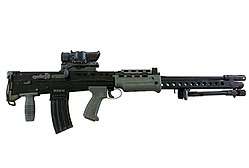

The L86 Light Support Weapon (LSW) is a magazine-fed squad automatic weapon originally intended to provide fire support at a fireteam level. The weapon has a heavier, longer barrel than the rifle and features a shorter handguard with an integrated bipod protruding from the front.[64] The stock has a shoulder strap to take the weapon's weight in the prone position and a rear vertical grip for better control of the weapon when firing bursts. The weapon is otherwise identical to the L85 version on which it is based, and the same magazines and sighting systems are used.[4][5][6][7] In addition to British Armed Forces use, the LSW was also adopted by MOD-sponsored cadet organisations.[65][7]
The increased barrel length, bipod and the optical performance of the SUSAT give the weapon excellent accuracy, increased muzzle velocity and greater effective range. From its inception, the L86 was a target of criticism on much the same basis as the L85. The LSW has the additional issue (shared by any light support weapon derived from a rifle, for example the heavy-barrel FN FAL) of its inability to deliver sustained automatic fire as it lacks a quick-change barrel, and belt feed.[43]
While the LSW was supposed to replace the L7A2 GPMG at the section level, the weapon's shortcomings meant that many units reverted to the GPMG (or held onto it if it had not already been replaced) and the role of a LSW was ultimately filled by the L110A1-A3 light machine gun, a belt fed weapon with a quick-change barrel in the same way as the GPMG.[27] Owing to its high level of accuracy in semi-automatic mode,[66] the primary use of the L86 shifted to that of a sharpshooter rifle following the introduction of the L110A1,[67] however it was replaced in this role by the L129A1 Sharpshooter Rifle.[68][27] The L86 was withdrawn from service in 2019.[52]
Carbine
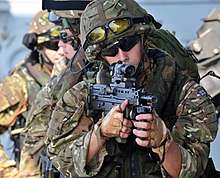
The length savings offered by the SA80's bullpup design meant that initially there were no plans for a carbine variant. By 1984 however, an extremely short prototype model was developed; the barrel terminated immediately in front of the pistol grip, which in combination with the lack of any sort of foregrip or handguard presented a risk of self-inflicted gunshot injuries if the firer's left hand was to slip forward. Two further prototypes appeared in 1989 and 1994; the former was slightly longer than the previous model (overall length 556 mm, barrel length 289 mm) and used the rear grip from the LSW as a foregrip, while the latter used a 17.4-inch barrel (length overall 709 mm, barrel length 442 mm) and was fitted with the handguard from the LSW.[27]
The fourth attempt (2003–2004) is also the only one to officially be adopted, being known as the L22 Carbine in British service; it resembles the 1989 model, including the foregrip which is now a purpose-made component which can be adjusted by the end user, but is constructed to A2 standards and has a 318 mm (12.5 in) barrel and an overall length of 565 mm. Around 1,500 were manufactured from surplus L86 LSWs; more were built with the increased demand, bringing the total to around 2,000.[27] The shortened barrel means that the carbine is less accurate than the rifle variant, especially at longer ranges; the official manual gives an effective range of 200 m while stating that the weapon's effectiveness beyond this is entirely dependent on the firer's skill.[5][6]
The version that was finally accepted for service was introduced during the A2 upgrade programme and so features the relevant markings and component assemblies[69] - official documentation disagrees over whether to refer to the weapon as the L22A1[5][6] or L22A2,[58] Initially issued to tank and armoured vehicle crews for emergency action out of vehicle, the L22's compact size has also led it to being used by the Royal Marines Fleet Protection Group as well as pilots and dog handlers of all three service branches.[27][70]
Cadet General Purpose Rifle
The L98 Cadet General Purpose (GP) Rifle is used for weapons training by MOD-sponsored cadet organisations such as the Army Cadet Force, Sea Cadet Corps and Air Training Corps. The L98A1 version was introduced in 1987 to replace the .303 Lee–Enfield No 4 rifles and .303 Bren guns (which had not been replaced by the SLR owing to that weapon's weight and recoil being too much for young cadets; the GP Rifle had no such problems,[27] and its suitability for cadet use was actually emphasised in official documentation.[65])
It was similar to the L85A1 but lacked the gas components, instead being a manually operated, single-shot weapon, with a cocking handle extension piece mounted on the right side of the weapon for this purpose. It was also distinguishable by the absence of a flash eliminator and only being fitted with adjustable iron sights. The L98A1 rifle began a phased decommission in early 2009 in favour of the updated L98A2 version;[7][28] this is virtually identical to the L85A2 rifle save for the absence of fully automatic capability and a plain foresight blade without a Tritium insert.[71][27]
Both Cadet GP Rifle variants also have a drill purpose version designated as the L103, used for teaching cadets the basics of the weapon they are handling and for rifle drill; this SA80 variant has been modified so as to render it a deactivated weapon and make subsequent reactivation uneconomical. It can be distinguished from live weapons by the use of a white cheek piece and handguard top cover, the bolt carrier assembly being painted red, and the letters 'DP' (Drill Purpose) being present towards the rear of the weapon.[72]
Conflicts
The SA80 has been used in all conflicts in which the British Armed Forces have been involved since its introduction in the early 1980s. Deployments include the following[27]:
- The Troubles (Operation Banner)
- Persian Gulf War (Operation Granby)
- Yugoslav Wars (Operation Grapple)
- Sierra Leone Civil War
- War in Afghanistan (Operations Veritas, Jacana, Herrick, and Toral)
- Iraq War (Operation Telic)
Users











Non-state users
- West Side Boys: Weapons taken from the Royal Irish Regiment patrol captured on 25 August 2000[76]
See also
- Steyr AUG - Austrian bullpup assault rifle.
- FAMAS - French bullpup assault rifle.
- F2000 - Belgian bullpup assault rifle.
- HS Produkt VHS - Croatian bullpup assault rifle.
- Tavor – Israeli bullpup assault rifle.
- QBZ-95 – Chinese bullpup assault rifle.
Notes
- Now called the Royal Bermuda Regiment following granting of this status on 1 September 2015
References
- "Denis Ferranti – A Global Defence Specialist – Denis Ferranti Group". dferrantigroup.com. Retrieved 30 May 2017.
- "High Precision Machined Parts – Denis Ferranti Machining". www.dferrantimachining.co.uk. Retrieved 30 May 2017.
- "British Army Vehicles and Equipment" (PDF). MoD. Archived from the original (PDF) on 19 November 2010.
- Ministry of Defence (United Kingdom) (1988). Army Code No. 71374, Infantry Training Volume II, Pamphlet No. 6 The SA 80 Rifle and Light Support Weapon (LSW) (All Arms).
- Ministry of Defence (United Kingdom) (2004). Army Code No. 71807, Infantry Training Volume II, Pamphlet No. 5 The SA80 A2 (5.56 mm) System (Rifle, Light Support Weapon and Carbine) and Associated Equipment.
- Ministry of Defence (United Kingdom) (2011). Army Code No. 71807, Infantry Training Volume II, Pamphlet No. 5 The SA80 A2 (5.56 mm) System (Rifle, Light Support Weapon and Carbine) and Associated Equipment.
- Ministry of Defence (United Kingdom) (2014). Army Code No. 71807-C, Cadet Training, The L98A2 Cadet GP Rifle (5.56 mm), L86A2 Light Support Weapon and Associated Equipment.
- "SA80 Rifle Gets An Upgrade". www.defense-aerospace.com.
- "Assault rifle (automatic) Enfield SA-80 / L85A1 / L85A2". tonnel-ufo.ru. Retrieved 30 May 2017.
- Meek, James (10 October 2002), "Off Target", The Guardian
- A Historical Review of Armalite: Edition of 4 January 2010 (PDF), ArmaLite Inc., archived from the original (PDF) on 12 June 2014,
It’s especially interesting to note that the RSAF’s later 5.56 mm rifle, the SA-80, (later adopted as the L85) was nothing more than a bullpup version of the AR-180
- Hogg, Ian V.; Weeks, John (1981), Military Small Arms of the 20th Century (4th ed.), ISBN 978-0-910676-28-1
- Macrae, Callum (23 August 1992), "How the Army got second best", The Observer, via historyofwar.org, p. 7,
In 1976 Edmiston and his designer, Frank Waters, saw the prototype SA80 at the British Army Equipment Exhibition in Aldershot. It was a bullpup design, a squat rifle with a minimal butt, and its operation looked curiously familiar.'Frank was allowed to take it apart,' Edmiston told The Observer. 'He found our bolt carrier, our clipazine, and parts out of our gun. These weren't even copies. They had bought some of our guns and were using the parts to make the SA80 prototype.' A former weapons designer with Royal Ordnance confirmed that claim. He added that the original prototypes, basically an amalgam of the Armalite AR18 and the bullpup design of the old RO EM2, were good, promising guns ... 'but the design was fiddled with by committees in the MoD and Royal Ordnance'. The gun, he says, has never been the same since.
- Dolazell, Harry, "Armalite / Sterling AR-18 5.56mm Rifle", www.gunmart.net,
if you ever take an SA80 apart, or see a picture of one fully disassembled, then look very closely at the bolt and gas system, as it’s almost a direct copy of the old AR-18 system
- A Historical Review of Armalite: Edition of 4 January 2010 (PDF), ArmaLite Inc., archived from the original (PDF) on 12 June 2014,
The AR-18 suffered similar results in the United Kingdom as well. The Ministry of Defence first evaluated the AR-18 in March 1966...A Howa version was evaluated by MOD in January 1969.
- The World's Assault Rifles by Gary Paul Johnston, Thomas B. Nelson, Chapter 29 Great Britain
- "SA80 History: The First Mockups (Sterling and Stoner)". forgottenweapons.com. 5 May 2017. Retrieved 30 May 2017.
- "British Enfield SA80 Part 1: Mock-ups – Armament Research Services". armamentresearch.com. Retrieved 30 May 2017.
- The World's Assault Rifles by Gary Paul Johnston, Thomas B. Nelson, Chapter 67
- http://img.photobucket.com/albums/v140/24626151/Guns/enfieldseffort.jpg
- http://img.photobucket.com/albums/v140/24626151/Guns/Stoner.jpg
- "SA80 History: XL70 Series Final Prototypes (Individual Weapon and LSW)". forgottenweapons.com. 13 May 2017. Retrieved 30 May 2017.
- Wetters-Chronology. "The 5.56 X 45mm: 1974–1985 – A Chronology of Development". Daniel Watters, The Gun Zone. Archived from the original on 4 May 2007. Retrieved 5 May 2007.
- "SA80 Series: The Pre-Production XL85 and XL86". forgottenweapons.com. 17 May 2017. Retrieved 30 May 2017.
- "SA80 (Small Arms for the 1980s): The Sorry Saga of the British Bulldog's Bullpup". www.historyofwar.org. Retrieved 30 May 2017.
- Williams, Anthony G., SA80: Mistake Or Maligned – And What Next?
- Grant, Neil (2016). SA80 Assault Rifles. Osprey Publishing. ISBN 978-1-4728-1104-2.
- "FOI2015_03633 Memo" (PDF). Ministry of Defence. 28 April 2015.
- "British Army's rifle set for multi-million-pound upgrade". Ministry of Defence. 11 April 2018.
- BERNEWS: Photos: Regiment Weapons Demonstration. 14 January 2013 Photographs 27 and 28 of 52
- "Rifles worth $1.4m donated to Regiment – The Royal Gazette: Bermuda News". royalgazette.com. 5 August 2015. Retrieved 30 May 2017.
- "Special Forces (Land) (Falkland Islands), Amphibious and special forces". Jane's Amphibious and Special Forces. 25 November 2010. Archived from the original on 15 August 2011. Retrieved 28 May 2018.
- https://www.facebook.com/2094635694139862/posts/over-the-last-few-weeks-all-ranks-have-been-training-on-the-l85a2-rifle-and-toni/2299255450344551/
- Watters, Daniel. "The 5.56 X 45mm: 1990–1994". Archived from the original on 4 January 2010. Retrieved 15 June 2009.
- Hogg, Ian; Weeks, John (1991). Military Small Arms of the 20th Century. London: Arms and Armour Press. p. 158. ISBN 978-1-854-09034-8.
[...] the first five years of this rifle's service have been disastrous. A number of manufacturing defects showed up in service conditions, and it was not until the closure of the RSAF at Enfield and the setting up of an entirely new production line, with new computer-controlled machine tools, at the new RSAF Nottingham, that the quality of the production weapons began to improve. It will take some time for the poor reputation gained by the initial issue weapons to be overcome; the only consolation is that the same sort of thing has happened to other military rifles in the past, and they have managed to live down their early reputation and prove their innate reliability. It is to be hoped that the L85A1 will do as well.
- Raw, Steve (2003). The Last Enfield – SA80: The Reluctant Rifle. Cobourg: Collector Grade Publications. ISBN 978-0-889-35303-9.
- Hogg, Ian; Adam, Rob (1996). Jane's Guns Recognition Guide. Glasgow: HarperCollinsPublishers. p. 367. ISBN 0 00 4709799.
- Off Target – The Guardian, 10 October 2002.
- for example the Bremner, Bird and Fortune satirical comedy documentary Between Iraq and a Hard Place included the line: "The SA80 is a lethal weapon, especially for anyone trying to fire it", similar to a description of the Vietnam War era M16.
- "The Defence Estimates 1990". Retrieved 23 December 2014.
- Ryan, Chris (2011). The One That Got Away. London: Arrow Books. p. 55. ISBN 978-0-099-55667-1.
- McNab, Andy (2013). Bravo Two Zero – 20th Anniversary Edition. London: Corgi. pp. 82–83. ISBN 978-0-552-16882-3.
- Hastings, Max (31 July 2004). "Don't Buy British". The Guardian. London.
- "SA80 individual weapon". Army.mod.uk. Archived from the original on 10 December 2015. Retrieved 22 April 2009.
- Harding, Thomas (16 October 2001). "Rifles up-dated in time for invasion". The Telegraph. London. Retrieved 15 September 2019.
- "Supply of Handguards and Downgrips for SA80A2". European Defence Agency.
The Combat Support Equipment Integrated Project Team (CSE IPT), part of the Ministry of Defence United Kingdom, has a requirement for design, production and supply of a new handguard and downgrip for the SA80A2 Rifle to give improved grip capability. There is a possible requirement for up to quantity 8,000 of each item for Urgent Operational Requirements. There is a further possible requirement for up to quantity 15,000 to replace in service equipment.
- "Kit Magazine, Issue 62 Winter 2007" (PDF). Ministry of Defence (United Kingdom). Archived from the original (PDF) on 1 October 2008. Retrieved 16 March 2008.
This technology is here now! So if you see strange-looking SA80s being carried by strange-looking men, then rest assured, those users that had the requirement, had the make-over, at a price.
- "Why won't you die? L85A3 prototype photos released to public -". 12 September 2016.
- "DSEI17 – H&K Unveil Upgrades to British SA80 -". 20 September 2017.
- "L85A3: The rifle that refuses to give up". 5 January 2018.
- Nicholls, Dominic; Dias, Duarte (2 November 2018). "New British Army rifle is among world's 'most lethal' weapons, military chiefs say". The Telegraph. Retrieved 3 November 2018.
- "Soldier Magazine". British Army. Retrieved 9 August 2018.
- "Desider magazine – Issue 36" (PDF). Ministry of Defence (United Kingdom).
- "Shield CQB". Retrieved 23 December 2014.
- "Troops in Afghanistan get new lightweight rifle magazines".
- "Magpul's EMAG gets 2nd window; Brits sign up for 1 million, thanks".
- Wyatt, Caroline (28 April 2009). "Remembering the Battle of Al Amara". BBC News. Retrieved 9 April 2011.
- Ministry of Defence (United Kingdom) (2009). Army Code No. 70166 (Revised 1990) [Amended 2009], The Drill Manual.
- "Kit Magazine" (PDF). Ministry of Defence (United Kingdom). Archived from the original (PDF) on 9 January 2008.
- "New Army kit helps soldiers see more clearly".
- "SA80 History: L85 A1 vs A2 (and the coming A3)". forgottenweapons.com. 20 May 2017. Retrieved 30 May 2017.
- Ministry of Defence (United Kingdom) (2009). Army Code No. 71882, Infantry Tactical Doctrine Volume 1, Pamphlet No. 3 Infantry Platoon Tactics.
- "Leading system supplier of 40mm weapons, ammunition and fire control technology" (PDF). Rheinmetall Defence. 13 September 2011.
- "Light support weapon". Army.mod.uk. Archived from the original on 10 December 2015. Retrieved 22 April 2009.
- Ministry of Defence (United Kingdom) (1990). Army Code No. 71462, The Cadet Training Manual Volume I.
- Hogg, Ian; Weeks, John (1991). Military Small Arms of the 20th Century. London: Arms and Armour Press. p. 293. ISBN 978-1-854-09034-8.
- "The Infantry - Small Arms in the Section". British Army. Archived from the original on 27 December 2005. Retrieved 23 June 2020.
With the introduction of the Light Machine Gun (LMG), the LSW will be used for longer range (600-800m), accurate, suppressive fire. It will become the sharpshooter system of the section to out-range any potential threat.
- "Taking Back The Infantry Half-km: Britain's L129A1". 8 June 2010.
- "SA80 History: L22A2 and Experimental L85 Carbines". forgottenweapons.com. 24 May 2017. Retrieved 30 May 2017.
- Neville, Leigh (2015). The British Army in Afghanistan 2006–14: Task Force Helmand. Osprey Publishing. p. 10. ISBN 9781472806758.
- Army Cadet Force. "L98A2 Cadet GP Rifle". Retrieved 16 April 2019.
- Air Cadet Organisation. "FIREARMS ACT COMPLIANCE – PHASE 2 – SERVICE WEAPONS" (PDF). Retrieved 16 April 2019.
- "Bolivian Police armed with SA80". 4 July 2011. Retrieved 1 February 2019.
- "SA80 in Bolivia". 31 December 2012. Retrieved 1 February 2019.
- Alpers, Philip (2010). Karp, Aaron (ed.). The Politics of Destroying Surplus Small Arms: Inconspicuous Disarmament. Abingdon-on-Thames: Routledge Books. pp. 168–169. ISBN 978-0-415-49461-8.
- Lewis, Damien (2005). Operation Certain Death. London: Arrow Books. ISBN 978-0-099-46642-0.
Bibliography
- Raw, Steve. The Last Enfield SA80: The Reluctant Rifle. Cobourg, Ontario, Canada: Collector Grade Publications Incorporated, 2003. ISBN 0-88935-303-4.
External links
| Wikimedia Commons has media related to SA80. |
- SA80 development from wooden mockups, XL60, XL70, XL85 & XL86 prototypes, to most recent versions at Forgotten Weapons
- SA80 A2 L85 Individual Weapon at Army.mod.uk